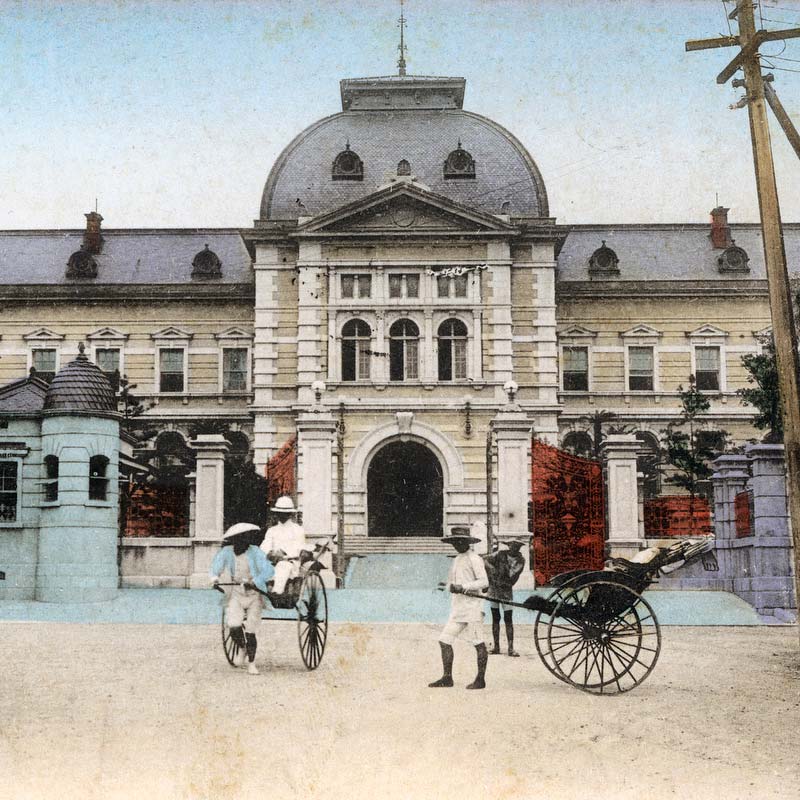A horse-drawn carriage has just passed through the Sakashita-mon Gate, while three jinrikisha (rickshaws) are waiting for passengers. In the back the Kunaisho (Imperial Household) building can be seen.
The Sakashita-mon was part of the original Edo Castle. First Shogun Tokugawa Ieyasu (1543-1616) made Edo Castle his base in the late 16th century and it remained the Tokugawa residence until 1867. The following year, the emperor moved in and it was was renamed Tokyo Castle (東京城). In 1869 (Meiji 3) it was renamed once again and became the Imperial Castle (皇城).
Interestingly, the Sakashita-mon originally faced north, but during the Meiji Period (1868-1912) it was changed to face east instead.
In February 1862, a small group of samurai from the Mito Domain attempted to assassinate Nobumasa Ando (1819-1871), a member of the shogun’s Council of Elders (老中), just outside this gate. In The Capital of The Tycoon, Rutherford Alcock (1809-1897), the first British diplomatic representative in Japan, describes how he received news of the attack at his residence in Yokohama:1
About ten o’clock at night the Governors arrived and made their communication, which was to inform us that a band of eight men had that morning attacked Ando Tsusimano Kami, the second of the Foreign Ministers, and the one supposed to be the most favorable to the maintenance of foreign relations. It appears they had taken their measures pretty much as they did when the Regent was attacked and killed; only, if possible, looking to the smaller number engaged, they had shown a more reckless and desperate courage, determining to kill, and willing to be killed, in the accomplishment of their object. The Minister was in his norimon, and proceeding to the palace in the midst of an armed retinue befitting his rank as a Daimio and a member of the Cabinet. The distance between his official residence and the palace is very short, and he had but to cross an open space or glacis to gain the bridge leading over the broad, deep moat which surrounds the Tycoon’s castle. Short, however, as was the distance, and exposed to view, these desperadoes were nothing daunted; for, as the train approached the bridge, a shot was fired, wounding one of the officers by the side of the norimon. Ando Tsusimano, it appears, instantly divined that he was to be attacked, and, throwing himself out of the norimon, drew his sword to defend himself. It was well he lost no time, for already his people were being cut down by the desperate band of assassins. The next instant he received a sabre-cut across the face, and a spear-thrust in the side that had wellnigh proved fatal. As in the previous case of the Regent, the life-and-death struggle was brief as it was bloody. In a few seconds seven of the assailants lay stretched, wounded or dead, on the ground, and one only (the eighth) escaped. Among the wounded, however, were some who lived long enough to have confessions extracted from them as to their motives and associates. The Ministers told me one of the wounded had confessed that among the assailants were some of those who had attacked the British Legation in July, and that it was partly from the same motives, and partly to avenge the execution of three of their confederates
Almost immediately after Alcock received the disturbing news about the attack on this top government official favorable to friendly relations with foreign nations, a fire broke out at the Foreign Settlement in Yokohama.2
It lasted several hours, and a large block of houses was destroyed. The danger of its spreading over the whole settlement was at one time very great, and that which made the event more serious was the fact of some men, dressed like the Japanese police, having been discovered by Lieutenant Aplin, at the commencement, actively engaged in spreading the fire to an adjoining house.
The British diplomat doesn’t show it in his memoirs, but he must have felt very much under siege.
Notes
1 Alcock, Rutherford (1863). The Capital of The Tycoon: A Narrative of a Three Years’ Residence in Japan. Harper & Brothers, Publishers: 336.
2 ibid: 337.
3 Imperial Household Agency Visit Guide.
Published
Updated
Reader Supported
Old Photos of Japan aims to be your personal museum for Japan's visual heritage and to bring the experiences of everyday life in old Japan to you.
To enhance our understanding of Japanese culture and society I track down, acquire, archive, and research images of everyday life, and give them context.
I share what I have found for free on this site, without ads or selling your data.
Your support helps me to continue doing so, and ensures that this exceptional visual heritage will not be lost and forgotten.
Thank you,
Kjeld Duits
Reference for Citations
Duits, Kjeld (). Tokyo 1880s: Sakashita-mon, OLD PHOTOS of JAPAN. Retrieved on December 12, 2025 (GMT) from https://www.oldphotosjapan.com/photos/761/sakashita-mon-imperial-palace




There are currently no comments on this article.